Oxford Street
| Oxford Street | |
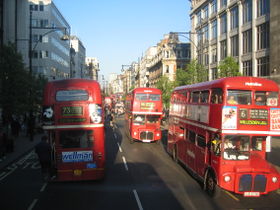 |
|
|---|---|
| The view east along Oxford Street, showing Routemaster buses before their withdrawal from routes serving the street | |
| Road number | |
| Location | Westminster, London, UK |
| Length (mi) | 1.5 miles (2.4 km) |
| Direction | East-West |
| Start | Marble Arch |
| End | Tottenham Court Road |
| Landmarks | Selfridges, Marble Arch, Oxford Circus |
| Known for | Shopping |
| Passes through | Central London |
Oxford Street is a major thoroughfare in the City of Westminster in London, England. There are 548 shops in Oxford Street; it is Europe's busiest shopping street, as well as the most dense.[1] The street was formerly part of the London-Oxford road which began at Newgate, City of London, when it was known as Oxford Road. Today the road forms part of the A40, although, like many roads in central London which are not now intended as through traffic routes, it is not signposted with the road number.
It runs for approximately a mile and a half (two and a half kilometres) from Marble Arch at the north east corner of Hyde Park, through Oxford Circus to St Giles Circus, at the intersection with Charing Cross Road and Tottenham Court Road. Eastwards, the road then becomes New Oxford Street until it runs into High Holborn. Oxford Street intersects with other London roads including Park Lane, New Bond Street and Regent Street. West of Marble Arch, Oxford Street becomes Bayswater Road, then Notting Hill Gate and Holland Park Avenue until it becomes the Uxbridge Road at Shepherd's Bush Roundabout. At Uxbridge it becomes the Oxford Road again, all the way to Oxford, save for some short sections where it has been given a local name.
At Oxford Circus is the notable diagonal crossing, opened in 2009, the only one of its kind in central London.
Contents |
History
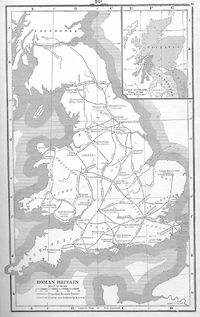
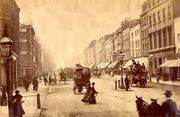
The street follows the route of a Roman road, the via Trinobantina, which linked Hampshire with Colchester and became one of the major routes in and out of the city.
Between the 12th century and 1782 it was variously known as Tyburn Road (after the River Tyburn that ran just to the south of it, and now flows underneath it), Uxbridge Road, Worcester Road and Oxford Road[2]. Note: Today the name Uxbridge Road is still used for the portion of the London—Oxford Road between Shepherds Bush and Uxbridge itself. It became notorious as the route taken by prisoners on their final journey from Newgate Prison to the gallows at Tyburn near Marble Arch. By about 1729, the road had become known as Oxford Street.[3]
In the late 18th century, many of the surrounding fields were purchased by the Earl of Oxford, and the area was developed. It became popular with entertainers including bear-baiters and masquerades, and for entertainment buildings such as the Pantheon. During the 19th century, the area became known for its shops.
Oxford Street is a square on the British Monopoly board. It is part of the green set together with Regent Street and Bond Street.
Oxford Street today
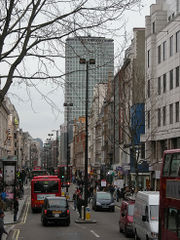
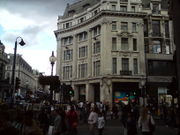
Oxford Street is home to major department stores and numerous brands' flagship stores, as well as hundreds of smaller shops. It is the major shopping street in central London, though not the most expensive or fashionable, and part of a larger shopping district with Regent Street, Bond Street and other smaller nearby streets.
For many British chain stores, their Oxford Street branch is regarded as their 'flagship' store and used for celebrity launches and promotions. Major stores include:
- Moss Bros., the formal wear hire shop has two addresses in Oxford Street
- Selfridges, a department store that has been on this site for a century. The second largest department store in the UK
- John Lewis, the flagship department store of the John Lewis Partnership, opened in 1864. The third largest department store in the UK
- Marks & Spencer, the famous retailer's flagship store of 170,000 square feet (16,000 m2), at the junction of Oxford Street and Orchard Street, is known as Marks & Spencer Marble Arch. It is the company's largest store. A second branch is located between Regent Street and Tottenham Court Road and stands on the site of the famous Pantheon building. Its fine polished black granite frontage completed in 1938 was awarded Grade II Listed Building status in September 2009.
- Debenhams, the flagship of this national mid-market chain. Originally known as Marshall & Snelgrove, the store took the name of its parent company, in 1973, after the store was rebuilt. The original Debenham & Freebody store was located in nearby Wigmore Street
- House of Fraser, the London flagship of another national department store housing premium brands. The store traded as D H Evans until 2000. It is located in an art-deco building completed in 1935; the first department store in the UK to include escalators serving every floor
- HMV, although it moved from its original location in 2000 after 80 years. HMV has three stores on the street including a concession within Selfridges and its shop at 150 Oxford Street, which is Europe's largest music shop at 50,000 square feet (5,000 m2)
- New Look, the flagship store of the fashion retailer that replaced a store that burned down in 2007, and supplants an existing store at Marble Arch. Located in the former Borders bookshop, which closed months prior to administration and subsequent liquidation. Features the largest shoe department and both women's and men's clothing ranges of the entire chain in the country.
- Schuh, the largest shoe store on Oxford Street, with the biggest range of branded footwear in London
- Disney Store, the UK flagship of the international brand
- Topshop, claimed to be "the largest fashion store in the world" [1]
- Primark, the flagship store of the Anglo-Irish low-price fashion retailer
- Uniqlo, the clothes store from Japan
- In the centre of Oxford Street where it intersects with Regent Street, and where the diagonal crossing is, Oxford Circus is home to four flagship chain stores: H&M, United Colors of Benetton, Niketown and until recently, Shelly's shoe store.
- Zara (clothing), flagship store from Spanish Inditex Group
- Bershka, flagship store from Spanish Inditex Group
- Pull and Bear, Spanish youth culture/urban style fashion retailer of the Inditex Group
- Urban Outfitters, home to retro and vintage clothing
- Gap, London flagship store
- Nike, Niketown London
- Adidas, a sports brand, has a store on Oxford Street opposite Selfridges
- Games Workshop, a British game production and retailing company
- There are also a number of stores on Oxford Street which operate on short term leases in empty retail units and advertise themselves as Closing Down Sales. However in some cases these Closing Down Sales can operate on rather a long term or even permanent presence [2]
- The Notebook Centre, located at 17 Oxford St, with sales dealing with computing, electronic and home goods. Flagship store, other branch located at Tottenham Court Road
Oxford Street can become congested both on the footpath, due to the high number of shoppers and tourists, and on the road as a result of the many buses routed along the street (see further under Transport below). Largely because of the diesel-engined traffic in the street (buses and taxis), annual average NO2 concentrations on Oxford Street are around 180 micrograms per cubic metre. This is four and a half times the EU target of 40 micrograms per cubic metre (Council Directive 1999/30/EC)[4].
Common sights on Oxford Street include preachers (such as Philip Howard who was at Oxford Circus), political demonstrations (such as the 2001 May Day protests and small scale protests) and Hare Krishnas.
Since 2004 Oxford Street has been made traffic-free on a Saturday before Christmas. In 2009 this was on Saturday 5 December, from 12 noon. It was promoted as "VIP Day", where VIP stands for Very Important Pedestrian.[5] The promoters were the New West End Company, which represents retailers and property owners in Oxford Street, Bond Street and Regent Street. Oxford Street was also made traffic-free on Saturday 23 May 2009, from 12 noon until 5 pm. This was the first time Oxford Street had been made traffic-free on a day in May. However the May traffic-free day was not repeated in 2010. The VIP Day before Christmas will be Saturday 27 November 2010.[6]
Christmas lights
Each Christmas the street is decorated with festive lights. In mid- to late November a celebrity turns on the lights and they remain on until 6 January (Twelfth Night).
The use of Christmas lights began in 1959, five years after its neighbour Regent Street had begun the tradition. In 1967, as the recession hit London, the lights were stopped and only returned in 1978 when Oxford Street organised a laser display.[7]
Celebrities who turned on the Christmas lights
- 2009 — Jim Carrey
- 2008 — Sugababes
- 2007 — Leona Lewis [8]
- 2006 — All Saints[9] (Peter André & Katie Price aka Jordan, G4, Andy Abraham)
- 2005 — Westlife [10]
- 2004 — Emma Watson, Il Divo, Steve Redgrave [11]
- 2003 — Enrique Inglesias
- 2002 — Blue
- 2001 — S Club 7
- 2000 — Charlotte Church [12]
- 1999 — Ronan Keating [13]
- 1998 — Zoë Ball
- 1997 — Peter André
- 1996 — Spice Girls
- 1995 — Coronation Street Cast
- 1994 — Lenny Henry
- 1993 — Richard Branson
- 1992 — Linford Christie
- 1991 — Westminster Children's Hospital
- 1990 — Cliff Richard
- 1989 — Gorden Kaye
- 1988 — Terry Wogan
- 1987 — Derek Jameson
- 1986 — Leslie Grantham, Anita Dobson
- 1985 — Bob Geldof
- 1984 — Esther Rantzen
- 1983 — Pat Phoenix
- 1982 — Daley Thompson
- 1981 — Pilin Leon (Miss World, Venezuela)
Transport
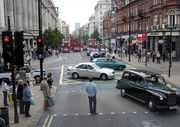
Oxford Street is served by the Central (which runs parallel beneath it), Jubilee, Bakerloo, Northern and Victoria London Underground lines, as well as many major bus routes.
Tube stations along Oxford Street, starting at Marble Arch (western-most):
- Marble Arch
- Bond Street
- Oxford Circus
- Tottenham Court Road
Current plans for Crossrail also include two stations serving Oxford Street at Bond Street and Tottenham Court Road.
Heavy congestion due to the number of stopping bus routes along Oxford Street, plus traffic crossing Oxford Street between Marylebone to the north and Mayfair and Soho to the south, led to proposals in 2006-08 from the New West End Company, the Mayor of London's office and several of the Mayoral candidates to pedestrianise Oxford Street with a tram service running end to end [14]. However the new Mayor, Boris Johnson, elected in May 2008, announced on 6 November 2008 that the Oxford Street Tram/Transit scheme would not be progressed within the TfL Business Plan 2009/10 – 2017/18 as the scheme was unaffordable and the disruption during construction would be very substantial. In response to a request from the Mayor, Transport for London undertook to reduce the bus flow in Oxford Street by 10% in each of 2009 and 2010.[15] In January 2009 the New West End Company had called for a 33% reduction in bus movements in Oxford Street.[16]
See also
- List of eponymous roads in London
- Stanley Green
References
- ↑ "Oxford Street gets its own dedicated local police team". The Londoner. September 2006. http://www.london.gov.uk/londoner/06sep/p7a.jsp. Retrieved 19 June 2007.
- ↑ Oxford Street: The Development of the Frontage, in Survey of London: volume 40: The Grosvenor Estate in Mayfair, Part 2 (The Buildings) (1980), pp. 171-173, from British History Online
- ↑ Tottenham Court Road in Old and New London: Volume 4 (1878), pp. 467-480, from British History Online
- ↑ "Developing a new Air Quality Strategy and Action Plan - Consultation on Issues". Westminster City Council. August 2008. http://www.google.co.uk/url?sa=t&source=web&ct=res&cd=1&ved=0CBgQFjAA&url=http%3A%2F%2Fwww3.westminster.gov.uk%2Fdocstores%2Fpublications_store%2FDeveloping%2520a%2520new%2520Air%2520Quality%2520Strategy%2520and%2520Action%2520Plan%2520-%2520Consultation%2520on%2520Issues.pdf&rct=j&q=eveloping+a+new+Air+Quality+Strategy+and+Action+Plan+-+Consultation+on+Issues&ei=EufmS6bVPNT-_Ab4vsSYCA&usg=AFQjCNETNo25zWDgO2TbBYePKnN02RhEAQ. See p 10
- ↑ "West End shoppers celebrate VIP Day". West End Marketing Alliance. 2009-12-10. http://www.westendlondon.com/Whats-Happening/West-End-shoppers-celebrate-VIP-Day.aspx. Retrieved 2010-05-21.
- ↑ "Shop West End Marketing Strategy 2010/11". http://www.newwestend.com/programmes/marketing_and_events/annual_plan. Retrieved 2010-05-21.
- ↑ "London's bright past". BBC. 22 December 1997. http://news.bbc.co.uk/1/hi/special_report/for_christmas/_new_year/christmas_decorations/41518.stm.
- ↑ "Leona to turn on Christmas lights". BBC. 29 October 2007. http://news.bbc.co.uk/1/hi/england/london/7067102.stm.
- ↑ "Energy row over Christmas lights". BBC. 9 November 2006. http://news.bbc.co.uk/1/hi/england/london/6132964.stm.
- ↑ "Westlife switch on festive lights". BBC. 15 November 2005. http://news.bbc.co.uk/1/hi/england/london/4436544.stm.
- ↑ "Festive switch-on for Potter star". BBC. 16 November 2004. http://news.bbc.co.uk/1/hi/entertainment/4012555.stm.
- ↑ "Charlotte lighting up London". charlottechurch.net. 21 November 2000. http://www.charlottechurch.net/news/arch11.html.
- ↑ "Boyzone star gets in Christmas spirit". BBC. 19 November 1999. http://news.bbc.co.uk/1/hi/entertainment/527422.stm.
- ↑ "Mayor's Oxford Street tram vision". BBC. 31 August 2006. http://news.bbc.co.uk/1/hi/england/london/5301366.stm. Retrieved 2010-05-09.
- ↑ "Streets ahead: Relieving congestion on Oxford Street, Regent Street and Bond Street". London Assembly Transport Committee. 4 February 2010. http://legacy.london.gov.uk/assembly/transport/2010/mar02/item06a.pdf. Retrieved 2010-05-09. See Appendix 1.
- ↑ "Way To Go January 2009". New West End Company. http://www.newwestend.com/generic/document/content/393. Retrieved 2010-05-21.
External links
- Oxford Street's official website
- Oxford Street - Mobile Shops & Restaurants Directory - Shop & Restaurant Locations on Oxford Street
- Love Oxford Street Shopping Directory - Lists businesses on or near Oxford Street including bars, clubs, hotels, restaurants and shops
- Oxford Street panorama
- Oxford Street landscape architecture
- Free Oxford Street Virtual Simulation
- Oxford Street Live Webcam
- London Shop Oxford St Shops
- Oxford Street Website Shops and info about Oxford Street